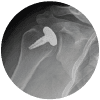Stemmed shoulder replacement has been the standard of care in modern shoulder arthroplasty. Ample reports indicate that total shoulder replacement provides better pain relief and functional outcomes when compared to a stemmed hemi arthroplasty. However, longer life expectancy, early joint deterioration in younger patients and increased functional demands from patients seeking a more active lifestyle, requires a more personalized approach to shoulder replacement. Increased patient demands combined with the overall invasiveness of a stemmed shoulder procedure, poor bone preservation, and the technical challenges of restoring joint height, version, angle and volume, underline the need for alternative primary arthroplasty solution.
Results from the 2015 Australian Shoulder Arthroplasty Registry emphasized the importance of implant selection particularly for younger patients: The report showed that the younger the patient age, the higher the revision rate. The Shoulder HemiCAP (1.7) had the lowest 5 Year revision rate across all implant classes on the market; onlay hemi resurfacing (11.2) was over 6 times higher, stemmed hemiarthroplasty (8.5) was 5 times higher and stemmed total shoulder replacement (8.2) was 4.8 times higher.
Based on these differences at the 5 year follow-up mark, implant selection, as evidenced with the inlay style implants, plays an important role when considering which joint replacement option is chosen as a primary.




